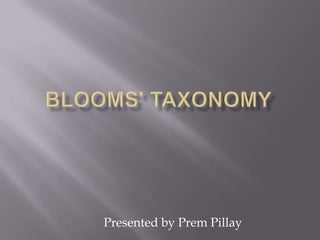
My Blooms Taxonomy
- 1. Blooms' Taxonomy Presented by Prem Pillay
- 2. BLOOMS TAXONOMY (1955) Benjamin Bloom (1913 -1999) created this classification (Taxonomy) to categorize the level of abstraction of questions that commonly occur in educational settings.
- 3. The Problems we face We really don't know if the student has received our deliverables. We attend to more than 30 participants at a time hence we are not sure of the learning abilities of each student. Not all the student perform in the same way as the best of them does, ironically the input or the our deliverables are the same to every student in the classroom
- 4. How does BT work for us?!! Lets understand BT first!!
- 5. The mind is not a vessel to be filled, but a fire to be ignited.(Plutarch)
- 6. The Theory Blooms Taxonomy is based on three basic domains. CONGNITIVE AFFECTIVE PSYCHOMOTOR
- 7. Cognitive Domain Knowledge: Recall and remember information. Comprehension: Understanding the meaning of…, interpolation (speaking), and interpretation of instructions and problems Application: Use a concept in a new situation. Applies what is learned in the classroom at the desktop.
- 8. Cognitive Domain Analysis: Separate concepts into parts to understand its basic structure. Distinguishing between facts and inferences (to draw conclusion by reasoning, justify the conclusion). Synthesis: Build a structure or pattern from diverse elements. Put parts together to form a whole new meaning or structure (emphasis on creativity).
- 9. Cognitive Domain Evaluation: Make judgments about the values of ideas or material.
- 10. Still not clear with the idea, lets look at it in a different way!!! Use Verbs (Kriyapadh)!!! KNOWLEDGE: defines, describes, identifies, knows, labels, lists, matches, names, outlines, recalls, recognizes, reproduces, selects, states, memorizes, tells, repeats, reproduces COMPREHENSION: converts, defends, distinguishes, estimates, explains, extends, generalizes, gives examples, infers, interprets, paraphrases, predicts, rewrites, summarizes, translates, shows relationship of, characterizes, associates, differentiates, classifies, compares, distinguishes.
- 11. APPLICATION: applies, changes, computes, constructs, demonstrates, discovers, manipulates, modifies, operates, predicts, prepares, produces, relates, solves, uses, systematizes, experiments, practices, exercises, utilizes, organize. ANALYSIS: analyzes, breaks down, compares, contrasts, diagrams, deconstructs, differentiates, discriminates, distinguishes, identifies, illustrates, infers, outlines, relates, selects, separates, Investigates, discovers, determines, observes, examines.
- 12. SYNTHESIS: categorizes, combines, compiles, composes, creates, devises, designs, explains, generates, modifies, organizes, plans, rearranges, reconstructs, relates, reorganizes, revises, rewrites, summarizes, tells, writes, synthesizes, imagines, conceives, concludes, invents, theorizes, constructs, creates. EVALUATION: appraises, compares, concludes, contrasts, criticizes, critiques, defends, describes, discriminates, evaluates, explains, interprets, justifies, relates, summarizes, supports, calculates, estimates, consults, judges, criticizes, measures, decides, discusses, values, decides, accepts/rejects
- 13. A turtle makes progress when it sticks its neck out.(Anon)
- 14. Affective Domain Receiving phenomena: Awareness willingness to hear Responding Phenomenon: Active participation, satisfaction in responding (motivation). Attend and react to a particular phenomena Valuing: A worth or value to a particular object. Simple acceptance to a state of commitment.
- 15. Affective Domain Organization: The emphasis is on comparing, relating, and synthesizing values. Internalizing values: behavior of being pervasive, consistent, predictable, and most importantly, having a characteristic of the learner.
- 16. A good teacher makes you think even when you don’t want to.(Fisher, 1998, Teaching Thinking)
- 17. Psychomotor Domain Imitation and Manipulation: Repeating an act that has been demonstrated it includes trial and errors. Precision: Response is complex and performed without hesitation. Articulation: Skills are so well developed that the individual can modify movement patterns to fit special requirements or to meet a problem situation.
- 18. Psychomotor Domain Naturalization: Response is automatic. One acts "without thinking."
- 19. Lets Review some important points. KNOWLEDGE: Recall or Recognition of Information Trainers role: Direct, Tell, Show, Examine, Question, Evaluate. participants role: Respond, Absorb, Remember, Recognize, Memorize, Passive recipient.
- 20. COMPREHENSION: Understanding of given Information. Trainers role: Demonstrate, Listen, Questions, Compare, Contrast, Examine. Student: Explains, Translates, Demonstrates, interprets, Active participant.
- 21. APPLICATION: Using methods, concepts, principles and theories in new situations. Trainers role: Shows, facilitates, observes, evaluates, Organizes, Questions. Student: Solves problems, Demonstrates use of Knowledge, Constructs, Active participant.
- 22. ANALYSIS: Breaking down of information into constituents and elements. Trainers role: Probes, Guides, Observes, Evaluates, acts as a resource, Questions, Organizes, Dissects. participants Role: Discuss, uncover, list, Active Participant.
- 23. SYNTHESIS: Putting together constituents or elements or parts to a whole. (emphasis on original or creative thinking). Trainers role: Reflects, extends, Analyses and Evaluates. participants role: Discuss, generalize, relates, compare, contrast, abstracts, active participant.
- 24. EVALUATION: Judging the values of ideas material and methods by developing and applying standards and criteria. Trainers role: Classifies, accepts, Harmonize, Guides. participants role: Judge, Dispute, Develop, Active Participant.
- 25. The BIG question ? How do we do it?!!!! How do we fit it in our daily training practices?!!!
- 26. The simple answer You are already doing, you just need to analyze your work and improve upon it
- 27. Lets make it simpler for you KNOWLEDGE, COMPREHENSION Practice this in your lectures
- 28. APPLICATION AND ANALYSIS Practice it while you assist your participants in the Lab / Hands On
- 29. SYNTHESIS AND EVALUATION Practice this while reviewing a previous days session.
- 30. This is as simple as it gets!!
- 31. This world is but a canvas for our imaginations. (Henry David Thoreau))
Editor's Notes
- 1.defines, describes, identifies, knows, labels, lists, matches, names, outlines, recalls, recognizes, reproduces, selects, states, memorizes, tells, repeats, reproduces.
